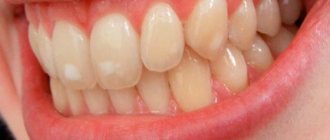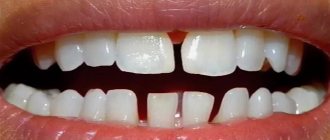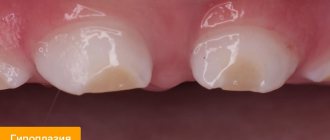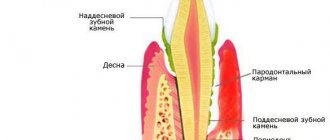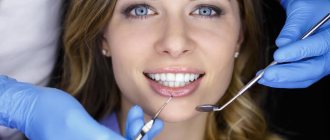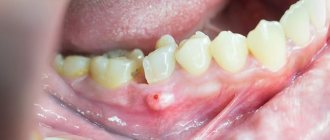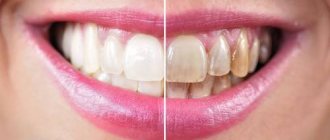The oral mucosa is susceptible to infection and inflammation due to the many microbes present here. Most often, complications arise due to decreased immunity. That is why various blisters on the gums and other parts of the oral cavity should alert a person and force them to seek professional advice and treatment. Small blisters and almost invisible rashes occur with dangerous viruses, and if left unchecked they can cause many problems.
Description
This unpleasant phenomenon can affect both adults and children, causing discomfort and pain when eating.
The appearance of white blisters on the gums as a result of damage to the oral mucosa contributes to burning and itching; such symptoms are especially painful for young patients.
It is not for nothing that experts say that the condition of the oral cavity is a kind of mirror that reflects the state of human health. You can provide first aid in the presence of such a pathology at home using traditional methods.
After treatment, preventive measures are required to prevent the recurrence of blisters on the gums. Externally, they appear as small transparent or white blisters, which are located in various places of the oral mucosa. Most often they appear in small groups. The inflamed areas become covered with a characteristic white or yellow coating.
Non-infectious diseases that can cause a lump on the gum
- Epulis.
A small growth that has some kind of stalk, which occurs mainly due to injuries, malocclusions, improper prosthetics, during teething (in children), and also due to hormonal disorders (less often). In appearance, epulis may resemble a tumor due to gingivitis, so diagnosing the disease may require x-rays and histological examination. - Ecostosis.
This pathology is a bone growth that is formed due to a jaw anomaly. The main cause of ecostosis is considered to be a genetic predisposition, but pathology can develop after injuries and traumatic tooth extraction. In this case, the bone extends beyond its usual boundaries, resulting in the formation of a noticeable lump. The disease is not accompanied by an inflammatory process, but it can occur due to mechanical damage to the growth. - Hematoma.
It is formed as a result of a strong blow and may well go away on its own or with the use of special means. If the tissue structure is disrupted as a result of injury, the help of a surgeon is needed.
Why do adults get blisters on their gums?
A person’s mouth constantly contains a large number of pathogenic organisms and microbes. Even with daily high-quality cleaning and proper care, the ideal balance is not achieved. Doctors, not without reason, consider the internal mucous membranes and tongue to be the dirtiest areas. Viruses easily enter the body when a patient coughs or talks, through the air or through the nasopharynx.
Blisters on the gums very often appear in the oral cavity. This rash looks like a soft lump that is filled with fluid. Its color can be whitish or pink; it turns brown due to impurities of pus or blood.
First signs
The first signs of blisters in the mouth:
- tingling, burning and itching in the mouth;
- the occurrence of pain;
- discomfort while chewing food;
- slight tissue swelling;
- dry mouth.
Based on external symptoms, the dentist can guess what caused the appearance of tumors on the mucous membrane:
- various microorganisms, fungi, infections;
- autoimmune conditions (chronic tuberculosis, hepatitis, HIV);
- allergies to food or drugs;
- consequences of a mouth burn from a hot drink or food;
- advanced conditions of periodontal disease, caries or pulpitis;
- exacerbation of inflammation of internal organs.
The dentist can make a more accurate diagnosis based on laboratory analysis of scraping the contents of the vesicle and the mucosal surface. The cause of blisters on the gums in half of the cases is the herpes virus.
Medical statistics say that active manifestations of this disease are observed in 80-90% of patients of different ages. Symptoms of the initial form or permanent relapse are most often diagnosed in children of the first year of life and elderly people with a weakened body.
Why blisters may appear on the gums
If the lump on the gum is white, pinkish or even red, filled with fluid and causes pain when pressed, it is most likely a periodontal abscess. The blister gradually swells as purulent masses form in it, and the reason for its appearance most often lies in infection through a periodontal pocket.
Why might a blister appear on the gum?
Important! A periodontal abscess (abscess) is a localized inflammation of a purulent nature. A cavity forms in the soft tissues, which gradually fills with pus. As a result, a round lump appears on the gum, which hurts greatly when pressed, and can even reach the size of a walnut.
The provoking factor can be anything: from a sharp drop in immunity to exacerbation of periodontitis or chronic injury to soft tissues. The integrity of the gums can be damaged, for example, by an incorrectly installed crown or an overhanging edge of a filling. Thus, the following processes and conditions lead to the formation of a purulent lump on the mucous membrane:
- penetration into the thickness of the mucous infection, including fungal,
- autoimmune pathologies: hepatitis, tuberculosis, HIV,
- allergies to food or medications,
- trauma to the mucous membrane: during and after dental treatment, when eating too hot food or drinks, damage from sharp edges of an orthodontic structure or due to banal biting,
- caries, pulpitis and periodontal disease in advanced form,
- exacerbation of inflammatory processes in internal organs,
- periostitis (flux).
“My child took a sip of hot tea, and the next morning a blister appeared on his gum. My husband and I were terribly scared and immediately took our little one to the dentist. The doctor carefully examined my mouth and said that there was nothing wrong, the gums were not damaged. We were prescribed chamomile rinses, and soon everything went away.”
TonyaK, Samara, from correspondence on the woman.ru forum
The most common cause of the formation of a white purulent blister on the gum is periostitis (flux). In this case, the growth occurs when the infection penetrates through the carious cavity into the pulp and leads to the development of inflammatory processes. At first, the disease may be asymptomatic. However, gradually the infection covers the tooth root, and purulent masses begin to accumulate at its base, which after some time come out and concentrate under the periosteum. The patient experiences acute pain while chewing food and brushing teeth. As a result, a white blister appears on the gum.
This is what periostitis looks like
In approximately 50% of cases, the cause of the appearance of small blisters on the mucous membrane is associated with the herpes virus. According to statistics, this disease is diagnosed in approximately 80-90% of people, and in different age categories1. In this case, the patient’s temperature may rise, general weakness may appear, and appetite may be impaired. A distinctive feature of herpes is that a scattering of small bubbles filled with liquid immediately appears on the gums. After some time, they burst on their own, and in their place painful ulcers appear, which take quite a long time to heal.
On a note! Viral pemphigus is another common phenomenon that leads to rashes on the mucous membrane. This pathological condition is the result of a sharp weakening of the immune system after a viral disease or chemotherapy. The rash eventually spreads to the palate, inner cheeks and throat.
By the way, a bubble on the gum often occurs after tooth extraction. In this case, the problem is usually associated with poor sterilization of the instruments used by the doctor during the procedure. As a result of infection, inflammation begins to develop in the mucous membrane, which then leads to the formation of a cyst full of purulent exudate.
Characteristic sign of herpes
A characteristic feature of oral herpes is a sudden jump in temperature. The patient feels severe weakness in the lower extremities, lack of appetite and a desire to sleep. Small blisters with clear or cloudy liquid appear on the inside of the cheek or gum. These areas hurt when touched, and they burn when eating. After a few days, they open and bright red wounds form. If treated incorrectly, the rash reoccurs and begins to spread to the larynx and palate. This is fraught with severe complications for humans.
How to treat an abscess on the gum with folk remedies?
In both cases, the cause of the development of the process is an infection that sits deep in the gum or bone. This means that we still won’t be able to influence it directly. Traditional methods (rinsing with herbs, applying propolis, etc.) usually bring their results: the fistula really goes away for a while. BUT! All these methods remove the effect, not the cause! Until the microbial contamination is removed, inflammation will progress. It won’t cause such discomfort, but it certainly won’t go away on its own.
Therefore, treatment should begin with a visit to the dentist to determine the cause. And only then, when you identify the cause and begin to fight it together with the doctor, you can also use traditional therapy, since rinsing with herbs really gives a good result after removing the stone, and, for example, sea buckthorn oil slightly speeds up the healing of wounds on the mucous membrane.
Other diseases
Another pathology that requires the patient’s attention and comprehensive medical supervision is viral pemphigus, which occurs when there is a sudden deterioration in the immune system after tonsillitis, flu or tonsillitis. This problem often complicates the life of cancer patients, occurring after chemotherapy in the mouth. It begins with the appearance of small white blisters on the gums, gradually moving to the inside of the lip, palate and throat. Pemphigus, like herpes, covers the mucous membrane completely, provokes high fever and weakening of the body due to intoxication. Translucent oral blisters can be found on the patient's head and body.
Often in adult patients, a blister appears after tooth extraction. This is primarily due to violation of sterilization standards for instruments. During a minor dental operation, a dentist may introduce bacteria into the wound. At the root, the process of inflammation begins and a cyst filled with purulent exudate is formed. The amount of pus gradually increases, and a blister appears on the gum.
Treatment for infectious diseases
Here, as with burns and injuries, you can’t do it on your own. You first need to see a doctor who will determine the type of disease and prescribe treatment. For example, for measles, herpes, candidiasis or stomatitis, treatment should be comprehensive:
- taking antiviral drugs,
- antifungal drugs,
- antiseptic treatment of the oral cavity,
- the use of local ointments,
- vitamin therapy: you need to strengthen the body from the inside to increase its resistance to bacterial attack,
- painkillers,
- diet correction,
- strengthening oral hygiene.
We deliberately do not list the names of drugs, because... For different infectious diseases, different medications will be effective, and only a doctor can determine the true cause of the pathology.
Reasons for the appearance of bubbles on the gums of a child
Due to its age, the child’s body does not have stable immunity and is not able to adequately resist viral diseases. A watery bump may indicate scarlet fever, measles or chickenpox. Stomatitis is especially common in children - a fairly common process of inflammation of the oral mucosa caused by candida fungi. It is characterized by the following symptoms:
- the appearance of blisters on the gums, as well as on the inner surface of the cheeks or lips;
- erosions that do not heal well;
- itching and burning in the mouth, exhausting the child;
- chills and fever;
- whitish coating on the palate and tongue;
- weakness and drowsiness.
The disease is easily transmitted through dirty household items, toys, and food, so dentists tell parents about the importance of observing all hygiene standards. At the initial stage, inflammation can be quickly stopped, and complications will be excluded.
Another problem for young patients is difficulty in cutting baby teeth. Often, before a molar or incisor appears, a small compaction filled with ichor forms on the gum. The doctor will sometimes gently open the blister to relieve pain and discomfort. With proper care, the wound will heal in a few days, and all unpleasant sensations will completely disappear.
A cyst on the gum of a child (in place of a tooth that has not yet erupted) –
A bluish-colored cyst on the gum can form 2-3 weeks before the eruption of a baby or permanent tooth (Fig. 7-9). Such a cyst does not at all look like an abscess on the gum, but looks like a lump filled with clear or bluish liquid. When touched, such a cyst is painless. Such cysts are not a pathology of dental development, are not associated with inflammation, and in most cases do not require any intervention (except for periodic examination by parents).
Cyst on a child’s gum: photo
A eruption cyst occurs in only a very small percentage of children. Dentist intervention may be necessary only if inflammation occurs, but this is extremely rare. The addition of inflammation will be indicated by pain when touched, temperature, swelling and redness of the mucous membrane.
If this lump bothers you, you can make a small incision under local anesthesia and release the fluid contained inside. Moreover, if part of the cyst wall is removed, then, as a rule, you can immediately see the upper part of the crown of the erupting tooth (Fig. 9). We hope that our article on the topic: A child has an abscess on his gum, what to do, was useful to you!
Sources:
1. Dental education of the author of the article, 2. Personal experience as a dentist, 3. The European Academy of Paediatric Dentistry (EU), 4. National Library of Medicine (USA), 5. “Pediatric therapeutic dentistry. National leadership" (Leontyev V.K.).
First aid
Small blisters on the gums, of course, need to be dealt with with the help of a doctor who will make a diagnosis and determine the real cause of the formations in the mouth. Regardless of the number and size of the bubbles, immediate contact with a specialist is required.
As first aid, it is allowed to use antiseptics, pharmaceuticals, disinfecting ointments and special solutions that need to be used to rinse the mouth. These drugs will soothe the mucous membrane, reduce irritation and reduce pain.
This effect can be achieved by using traditional medicine methods.
First aid at home: do's and don'ts
What can you do
A bubble on the gum of an adult or a child in most cases “signals” the presence of some kind of disease. Therefore, there is no need to think about how to remove it yourself - this should be done by a doctor. However, before you see a specialist, who will make an accurate diagnosis and prescribe treatment procedures, you can alleviate the condition and prevent the infection from spreading throughout the body.
If there are painful sensations, then a cold compress (apply only on the outside of the cheek, after wrapping the cold compress in a soft towel or cloth) and taking analgesics will help get rid of them. To disinfect the oral cavity, you need to use rinses based on a decoction of herbs, soda and salt. For rinsing, you can use Miramistin and Furacilin.
What not to do
You should not use antibiotics without consulting a doctor. Also, under no circumstances should you heat the painful area, because such actions will only aggravate your situation, causing the rapid spread of infection throughout the body.
You cannot open a bubble on your gum yourself. You cannot treat it with brilliant green, iodine or potassium permanganate, alcohol tinctures, propolis, because this can lead to injury and burns of the mucous membrane, and an allergic reaction.
Treatment of blisters
You can get rid of blisters on the gums near the tooth if the diagnosis was made correctly by an experienced doctor. Therefore, there is no need to delay your trip to a specialist and lead the pathology to significant complications, risking your own health and loss of teeth. For a blister on the gum caused by a recurrence of herpes infection, the patient is prescribed several therapeutic measures:
- taking antiviral drugs orally (Akiclovir);
- immunity is strengthened through a vitamin complex, aloe vera extract and a course of immunoglobulins;
- a special diet with a reduced content of sweet and rich foods, fats and canned food;
- treating wounds after a blister breaks with antiseptic and healing agents: Metrogyl Denta, Chlorophyllipt, Cholisal.
For rashes due to candidiasis, therapy is based on the use of antifungal drugs. The oral cavity and gum blister are lubricated with a solution of Candida, Decamine or nystatin ointment. For treatment of stomatitis to be effective, the patient needs to take a course of Amphoterecin and Clotrimazole tablets. A good way to remove plaque in the mouth and fight itching is by rinsing with plain soda, which is diluted in warm water.
If there is severe pain due to a bubble on the gum and it is impossible to rest or eat, dentists recommend treating this area with antiseptic ointments. They contain anti-inflammatory substances and gently freeze the nerve endings for several hours. Moreover, most of them can be used to treat children to eliminate discomfort during teething: “Pansoral”, “Kamistad”, “Cholisal”, “Kalgel”.
How else to treat blisters on the gums of an adult and a child?
What to do if a blister appears on your gum - causes and symptoms
When a suspicious bubble appears on the oral mucosa, it is always unpleasant and alarming. In such a situation, a person inevitably begins to be tormented by questions regarding where the blister on the gum came from and what to do with it now. Neither adults nor children are immune from this problem. One bump or a whole scattering of bubbles may appear on the mucous membrane; they may differ in size, shape and even color, be accompanied by pain or have no associated symptoms at all. All these characteristics are taken into account by the specialist when making a diagnosis. Later in this article we will figure out what it can mean if a purulent or watery bubble appears in the mouth, what could cause it to appear and how to treat it.
Traditional recipes against inflammation
An affordable and effective way to reduce a blister on the gum is to apply a softened piece of propolis. This natural remedy contains many healing substances that eliminate itching and pain, and reduce swelling around the vesicle. The component can be mixed with Kalanchoe or aloe pulp, fresh honey.
For inflammation of the oral cavity, you can rinse it with decoctions of the following plants:
- sage and chamomile soothe mucous membranes;
- calendula and St. John's wort promote faster wound healing;
- oak bark will eliminate pathogenic microbes.
It is important to follow preventative rules to keep your gums healthy. Dentists advise eating as many dishes with fiber and vegetables as possible, replacing sweets with fruits, and eating sour-milk products. When brushing your teeth, do a small massage by pressing on the mucous membrane, this way the blood will flow.
Is it dangerous that a bubble appears on the gum?
What to do if a blister appears due to a burn or injury
If a bubble filled with clear liquid swells on the gum, then you need to know how to act correctly.
Firstly, you cannot open it yourself, because... then bacteria from saliva will penetrate into the open wound, and the inflammatory process will begin. And your main task is to ensure sterility of the neoplasm and promote rapid healing of soft tissues. To do this, you can apply compresses with Solcoseryl or Metrogyl Denta gel to the damaged area. You can lubricate the mucous membrane with aloe juice or sea buckthorn oil.
Secondly, while the damaged tissues are healing, try not to eat “irritating” foods (sour, spicy, hard, hot and cold).
Important! If the bubble opens without your help, then ensure it is sterile. To prevent infection from entering the wound, rinse your mouth after each meal with a soda solution or chamomile. The damaged area can be treated with Levomekol or Cholisal for speedy tissue regeneration.
Prevention
Like treatment, the prevention of small blisters on the gums will be determined by the causes of the disease. But there are several general recommendations that apply to all cases.
Compliance with the rules of hygienic treatment of the oral cavity is of paramount importance. Every 3-4 months you need to buy a new toothbrush, use mouthwash and dental floss. Taking vitamin and mineral complexes and fresh dairy products is also an excellent preventive measure against the appearance of blisters in the mouth.
It is necessary to stop smoking as much as possible, limit the consumption of alcoholic beverages and exclude snack foods and processed foods from your diet.
It is easier to prevent any disease rather than treat it. That is why it is necessary to monitor the condition of the oral cavity, wash fruits and vegetables well before eating and carefully monitor that children do not put foreign objects in their mouths.
If all recommendations are followed, a person will not be affected by the problem of transparent bubbles appearing on the gums.
Exacerbation of periodontitis
Cause and mechanism of development
Periodontitis is an inflammatory disease associated with infection in the bone at the apex of the tooth root. Infection can enter the bone in different ways: through a tooth root canal or through a periodontal pocket.
- In the first case, the development of the disease begins with caries. If caries is not cured in time, the infection spreads deep into the tooth and causes pulpitis, and if further untreated, microorganisms spread deeper along the neurovascular bundle inside the tooth and reaches the bone.
- In the second case, the cause of infection in the bone is a problem in the interdental space (deep pocket). Inflammation of the gums can begin due to the accumulation of tartar, due to chronic injury from the sharp edge of a crown or filling, due to improper position of the tooth in the arch, and for many other reasons. Gradually, inflammation from the gums spreads to the circular ligament of the tooth, the ligament is destroyed, allowing microbes access to the space between the tooth root and the alveolar bone.
In both cases, the entry of microbes into the bone is accompanied by the release of a large amount of toxins, the bone begins to deteriorate, and in its place a cavity filled with pus forms. The process can go relatively unnoticed, causing inconvenience to the patient only during periods of exacerbation against the background of acute respiratory infections or other conditions accompanied by a general decrease in immunity.
Gradually accumulating, the pus continues to dissolve the bone, causing the inflammation to become larger. At the moment when the amount of pus reaches a critical level (or, due to a decrease in immunity, it becomes more), the pus begins to look for a way out. The bone gradually dissolves, passages are formed through which pus comes out under the periosteum and at some point a breakthrough occurs. Through this fistula, the pus comes out, and the original process returns to its chronic course.
Symptoms
Outside of periods of exacerbation, manifestations of periodontitis are minimal. This may be discomfort when biting on a tooth, or when pressing on the gum in the area of the causative tooth, but there are no other manifestations.
During the period of exacerbation, the following symptoms occur:
- acute pain when biting on a tooth (before an abscess appears on the gum), and after the fistula opens and the pus flows out, the pain goes away;
- the feeling of a grown tooth (also goes away after opening the fistula);
- pain and swelling of the gums in the area of the causative tooth;
- A whitish bubble appears on the gum, filled with liquid contents, when opened, pus flows out.
Symptoms of general intoxication may occur: fever, general weakness, lethargy, headache.
Diagnosis and treatment
To make an accurate diagnosis, they collect anamnesis, examine the oral cavity and the possible causative tooth, and be sure to take an x-ray.
The x-ray will show dark areas in the bone that are located in the area of the tooth root. The size of these lesions can vary from a few millimeters to a centimeter in diameter or more. Most often, an x-ray can tell you exactly where the source of infection is located, on which root (or between the roots of the teeth). The image determines the condition of the bone, the condition of the causative tooth and a possible prognosis for the future life of the tooth. Based on these data, a decision is made on the treatment method.
Possible treatment options for periodontitis in the acute stage
- Therapeutic treatment. This method involves removing nerve remnants from the canals (or unsealing them if the tooth has previously been treated), antiseptic treatment of the root canals, introducing medicinal drugs into the canal, and after some time (from a week to several months) the canals in the tooth are permanently sealed . It is assumed that with this treatment the source of infection will be removed (more than 90% of microorganisms responsible for the development of periodontitis live not in the bone itself, but in the root canal system, so high-quality canal treatment often leads to complete victory over the infection and restoration of the bone). After time (six months to a year), the bone is completely restored, and the gums heal with the formation of an invisible scar. To speed up the healing of the fistula tract, it is sometimes washed with a weak antiseptic solution or cleaned with ultrasound.
- Surgical treatment with tooth preservation. There are several options for this operation. If the inflammation is at the apex of the root, then the apex of the root is removed (the operation is called “resection of the apex of the tooth root”) and the cavity in the bone is cleaned. This method assumes that the canals are well sealed, at least 2/3 of their length. The second option is to remove half the tooth (hemisection operation). This type of operation is performed on multi-rooted teeth if inflammation is observed on one root, and the second root does not have such problems. The third option (when there is inflammation between the roots in a multi-rooted tooth) - the tooth is left unchanged, and only the bone between the roots of the tooth is cleaned. All these methods assume that the inflammation came from the tooth, and not through the periodontal pocket (since if the infection came through the pocket, then after the intervention the cavity will soon be populated with microbes again, and the inflammation will progress further). For each of these operations there are certain conditions, the observance of which is mandatory for a favorable prognosis. Thus, resection is carried out only if the canal is well sealed, at least 2/3 of the length, hemisection also implies that the root that remains in the bone will be well treated, and cleaning between the roots is carried out only if all canals are well sealed.
- A combination of therapeutic and surgical treatment. If the tooth has not been previously treated (or has been treated, but the canals are poorly sealed), then before undergoing any of the above operations, the tooth must be prepared. Therefore, the canals are treated first, and only then surgical intervention is performed.
- Removal of a tooth. If the focus of destruction in the bone is large (for each patient and for different teeth the concept of “large” will also be different), if the infection came through the periodontal pocket, if the tooth is not valuable for further prosthetics, the canals in it are impassable, there are cracks and there are other - conditions due to which the tooth cannot (or is impractical) to be saved, such a tooth is removed. You need to understand that sometimes doctors leave something that, by and large, would need to be removed, and sometimes, on the contrary, they remove a tooth that could still be fought for. As an example: they leave mobile teeth in elderly people, since they are the only ones that hold a removable denture, or they remove a tooth with inflammation between the roots in a young patient in order to preserve bone volume for future implantation. In any doubtful case (when you can try to treat it, or you can immediately remove it), they focus on a further prosthetic plan. If implantation is planned, it is better to remove all questionable teeth, and if bridges or removable dentures are used, they try to fight for every tooth.
You can read more about treatment and operations in the article about jaw cysts.



